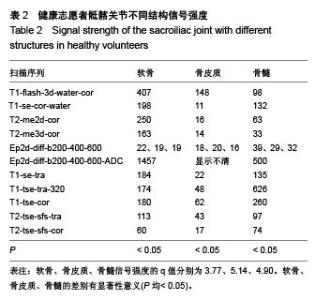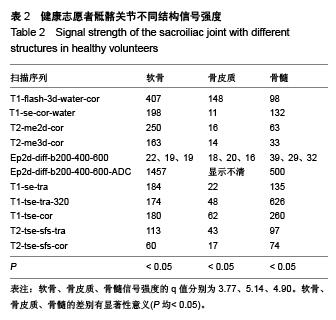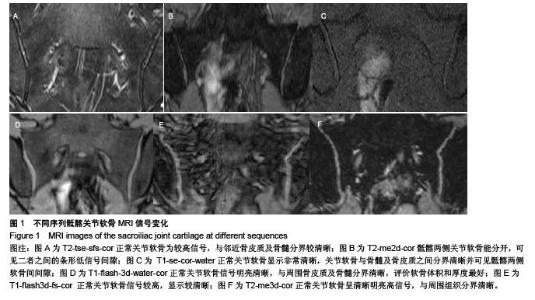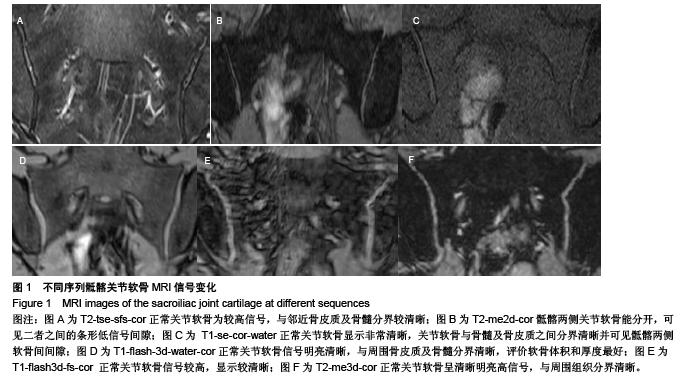Chinese Journal of Tissue Engineering Research ›› 2015, Vol. 19 ›› Issue (51): 8223-8227.doi: 10.3969/j.issn.2095-4344.2015.51.005
Previous Articles Next Articles
Comparative study on different sequence MRI imaging of the sacroiliac joint cartilage
Liu Bo1, Shi Da-peng2, Zheng Fu-zeng3, Sun Yong-qiang3, Yang Zhong-jie1, Wang Tong-ming1
- 1Department of Radiology, Henan Province Hospital of TCM, Zhengzhou 450002, Henan Province, China; 2Imaging Center, Henan Provincial People’s Hospital, Zhengzhou 450003, Henan Province, China; 3Department of Orthopedics, Henan Province Hospital of TCM, Zhengzhou 450002, Henan Province, China
-
Received:2015-10-21Online:2015-12-10Published:2015-12-10 -
Contact:Shi Da-peng, M.D., Chief physician, Imaging Center, Henan Provincial People’s Hospital, Zhengzhou 450003, Henan Province, China -
About author:Liu Bo, Master, Attending physician, Department of Radiology, Henan Province Hospital of TCM, Zhengzhou 450002, Henan Province, China -
Supported by:the Scientific Tackle Key Project of Henan Province, No. 132102310159
CLC Number:
Cite this article
Liu Bo, Shi Da-peng, Zheng Fu-zeng, Sun Yong-qiang, Yang Zhong-jie, Wang Tong-ming. Comparative study on different sequence MRI imaging of the sacroiliac joint cartilage[J]. Chinese Journal of Tissue Engineering Research, 2015, 19(51): 8223-8227.
share this article
| [1] 王继荣,刘成环,孙晓芹.强直性脊柱炎骶髂关节的CT诊断价值[J].青海医药杂志,2013,43(2):73-75.
[2] 俞永梅,徐亮,张锡龙,等,X线,CT和MRI在强直性脊柱炎骶髂关节病变中的诊断价值[J].皖南医学院学报,2013,5(1):404-407.
[3] 朱利君,王利伟,钱少圭,等,磁共振诊断强直性脊柱炎骶髂关节病变的价值[J].中国CT和MRI杂志,2012,10(5):86-88.
[4] Mager AK, Althoff CE, Sieper J, et al. Role of whole body magnetic resonance imaging in diagnosing early spondyloarthritis.Eur J Radio.2009; 71:182-188.
[5] Wittram C,Whitchouse GH. Nomal variation in the magnetic resonance imaging appearances of the sacroiliac joints pitfalls in the diagnosis of sacroliitis.Clin Radiol.1995; 50(6):371-376.
[6] Modl JM, Sether LA, Haughton VM, et al.Articular cartilage: correlation of histologic zones with signal intensity at MR imaging, Radiology.1991; 181:853-855.
[7] loeuille D,Olivier P,Watrin A,et al.The biochemical content of articular cartilage:an original MRI approach.Biorheology. 2002; 39(1-2):269-276.
[8] 黄振国,张雪哲,洪闻,等.早期强直性脊柱炎骶髂关节病变的X线、CT和MRI对比研究[J].中华放射学杂志,2011,45(11):1040-1044.
[9] Ganz R,Leunig M,Leunig-Ganz K,et al.Theetiology of osteoar th r itis of the hip:integ rated mechanical concept. Clinorthop. 2008; 466(2):264-272.
[10] 刘丙木,王淑梅,崔建岭,等,10-20岁健康志愿者骶髂关节软骨MRI序列对照研究[J].临床放射学杂志,2008,2(12):1786-1789.
[11] Marzo-Ortega H, McGonagle D, Bennett AN. Magnetic resonance imaging in spondyloarthritis.Curr Opin Rheumatol. 2010;22(4):381-387.
[12] Malaviya AP, Ostor AJ.Early diagnosis crucial in ankylosing spondylitis. Practitioner.2011;255(1746):21-24.
[13] Vander Cruyssen B, Munoz-Gomariz E, Foni P, et al .Hip involve menin ankylosing spondylifs:epide miology and risk factors associated with hip replace ment surgery. Rheumatology(Oxtord).2010;49(1):73-81.
[14] Ai F,Ai T,Li X,et al. value of diffusion-weighted magnetic resonance imaging in early diagnosis of ankylosing spondylitis. Rheumatol Int.2012;32(12):4005-4013.
[15] Sanal HT, Yilmaz S, Kalyoncu U, et al. alvalue of DWI in visual assessment of activity of sacroiliitis in longstanding ankylosing spondylitis patients.Skeletal Radiol.2013;42(2):289-293.
[16] 艾飞,田丹,张炜,等.磁共振弥散加权成像诊断早期强直性脊柱炎的价值[J].中华医学杂志,2013,93(11):811-815.
[17] 俎金燕,王晨光,贾宁阳,等.腰椎间盘退行性变的磁共振弥散加权成像研究[J].实用放射学杂志,2013,29(4):611-614.
[18] Pan C,Hu DY,Zhang W,et al. Role of diffusion-weighted imaging in early ankylosing spondylitis.Chin Med J(Engl). 2013;126(4):668-673.
[19] Dallaudiere B,Dautry R,Preux PM,et al.comparison of apparent diffusion coefficient in spondylarthritis axial active inflammatory Lesions and type 1 Modic changes.Eur J Radiol. 2014;83(2):366-370.
[20] 丁庆国,贾传海,陆永明,等.振对强直性MRI联合DWI在强直性脊柱炎诊断中的价值,[J].临床放射学杂志,2012,31(5):693-696.
[21] 冯勋树,张俊湖,杨君.急性期脑梗死患者弥散加权成像皮质层状坏死表现的临床意义[J].中华行为医学与脑科学杂志, 2012, 21(3):255-257.
[22] 王健,姚秀忠,饶圣祥,等.3.0T磁共振弥散加权成像在胰腺癌中的应用价值[J].医学影像学杂志,2012,22(1):91-93.
[23] Baraliakos X, Braun J.Hip involve ment in ankylosing spondylitis:what is the verdict Rheumatology(Oxtord). 2010; 49(1):3-4. |
| [1] | Chen Ziyang, Pu Rui, Deng Shuang, Yuan Lingyan. Regulatory effect of exosomes on exercise-mediated insulin resistance diseases [J]. Chinese Journal of Tissue Engineering Research, 2021, 25(25): 4089-4094. |
| [2] | Chen Yang, Huang Denggao, Gao Yuanhui, Wang Shunlan, Cao Hui, Zheng Linlin, He Haowei, Luo Siqin, Xiao Jingchuan, Zhang Yingai, Zhang Shufang. Low-intensity pulsed ultrasound promotes the proliferation and adhesion of human adipose-derived mesenchymal stem cells [J]. Chinese Journal of Tissue Engineering Research, 2021, 25(25): 3949-3955. |
| [3] | Yang Junhui, Luo Jinli, Yuan Xiaoping. Effects of human growth hormone on proliferation and osteogenic differentiation of human periodontal ligament stem cells [J]. Chinese Journal of Tissue Engineering Research, 2021, 25(25): 3956-3961. |
| [4] | Sun Jianwei, Yang Xinming, Zhang Ying. Effect of montelukast combined with bone marrow mesenchymal stem cell transplantation on spinal cord injury in rat models [J]. Chinese Journal of Tissue Engineering Research, 2021, 25(25): 3962-3969. |
| [5] | Gao Shan, Huang Dongjing, Hong Haiman, Jia Jingqiao, Meng Fei. Comparison on the curative effect of human placenta-derived mesenchymal stem cells and induced islet-like cells in gestational diabetes mellitus rats [J]. Chinese Journal of Tissue Engineering Research, 2021, 25(25): 3981-3987. |
| [6] | Hao Xiaona, Zhang Yingjie, Li Yuyun, Xu Tao. Bone marrow mesenchymal stem cells overexpressing prolyl oligopeptidase on the repair of liver fibrosis in rat models [J]. Chinese Journal of Tissue Engineering Research, 2021, 25(25): 3988-3993. |
| [7] | Liu Jianyou, Jia Zhongwei, Niu Jiawei, Cao Xinjie, Zhang Dong, Wei Jie. A new method for measuring the anteversion angle of the femoral neck by constructing the three-dimensional digital model of the femur [J]. Chinese Journal of Tissue Engineering Research, 2021, 25(24): 3779-3783. |
| [8] | Meng Lingjie, Qian Hui, Sheng Xiaolei, Lu Jianfeng, Huang Jianping, Qi Liangang, Liu Zongbao. Application of three-dimensional printing technology combined with bone cement in minimally invasive treatment of the collapsed Sanders III type of calcaneal fractures [J]. Chinese Journal of Tissue Engineering Research, 2021, 25(24): 3784-3789. |
| [9] | Qian Xuankun, Huang Hefei, Wu Chengcong, Liu Keting, Ou Hua, Zhang Jinpeng, Ren Jing, Wan Jianshan. Computer-assisted navigation combined with minimally invasive transforaminal lumbar interbody fusion for lumbar spondylolisthesis [J]. Chinese Journal of Tissue Engineering Research, 2021, 25(24): 3790-3795. |
| [10] | Hu Jing, Xiang Yang, Ye Chuan, Han Ziji. Three-dimensional printing assisted screw placement and freehand pedicle screw fixation in the treatment of thoracolumbar fractures: 1-year follow-up [J]. Chinese Journal of Tissue Engineering Research, 2021, 25(24): 3804-3809. |
| [11] | Shu Qihang, Liao Yijia, Xue Jingbo, Yan Yiguo, Wang Cheng. Three-dimensional finite element analysis of a new three-dimensional printed porous fusion cage for cervical vertebra [J]. Chinese Journal of Tissue Engineering Research, 2021, 25(24): 3810-3815. |
| [12] | Wang Yihan, Li Yang, Zhang Ling, Zhang Rui, Xu Ruida, Han Xiaofeng, Cheng Guangqi, Wang Weil. Application of three-dimensional visualization technology for digital orthopedics in the reduction and fixation of intertrochanteric fracture [J]. Chinese Journal of Tissue Engineering Research, 2021, 25(24): 3816-3820. |
| [13] | Sun Maji, Wang Qiuan, Zhang Xingchen, Guo Chong, Yuan Feng, Guo Kaijin. Development and biomechanical analysis of a new anterior cervical pedicle screw fixation system [J]. Chinese Journal of Tissue Engineering Research, 2021, 25(24): 3821-3825. |
| [14] | Lin Wang, Wang Yingying, Guo Weizhong, Yuan Cuihua, Xu Shenggui, Zhang Shenshen, Lin Chengshou. Adopting expanded lateral approach to enhance the mechanical stability and knee function for treating posterolateral column fracture of tibial plateau [J]. Chinese Journal of Tissue Engineering Research, 2021, 25(24): 3826-3827. |
| [15] | Zhu Yun, Chen Yu, Qiu Hao, Liu Dun, Jin Guorong, Chen Shimou, Weng Zheng. Finite element analysis for treatment of osteoporotic femoral fracture with far cortical locking screw [J]. Chinese Journal of Tissue Engineering Research, 2021, 25(24): 3832-3837. |
| Viewed | ||||||
|
Full text |
|
|||||
|
Abstract |
|
|||||



